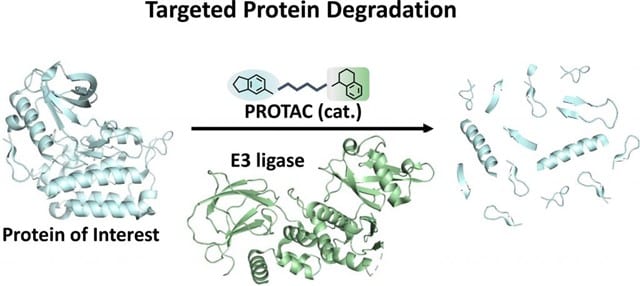Bivalent molecules (PROTACs, LYTACs, AUTACs, etc.) designed to induce protein proximity to and subsequent degradation by the proteasome are promising new modalities for therapeutic intervention[1],[2],[3]. The most well-known are the PROTAC® degraders leveraging the E3 ligase system, and these are currently progressing in clinical studies. Symeres scientists recently published a review where more background on PROTACs can be found [3].
At Symeres, we have developed a modular toolbox platform to support our clients’ needs. It simultaneously addresses several aspects particular to bifunctional degraders:
- The linker often plays a determining role in the efficiency and selectivity of these molecules. Using our collection of preformulated building blocks, we can rapidly and cost-effectively generate libraries of 10–30 (or larger) compounds to be tested in relevant assays.
- A challenge with bifunctional molecules can be their physicochemical properties due to their size and lipophilicity. We have vast experience with the synthesis, analysis, and purification of these compounds, which can be significantly more challenging than that with traditional small-molecule ligands.
The toolbox
To specifically support the early-stage development of PROTACs, we have developed a modular chemistry toolbox, in which different linking strategies are combined with optimized analytical routines. We offer:
- a selection of E3 ligase ligands, including various CRBN, VHL, and cIAP analogs;
- a set of >100 linker constructs of different lengths, composition (alkyl/PEG), and chemical handles;
- established chemistry to couple the linkers to the target ligand, using a variety of coupling conditions.
Beyond the toolbox
While for speed and cost considerations it is advantageous to focus on a toolbox approach at the start of a bifunctional molecule project, ultimately, one will need to optimize both potency and physicochemical/ADME-PK parameters. This requires the bespoke synthesis of linker variants, or sometimes even tuning of the ligand interacting with the protein that is to be degraded. Working multiple toolbox projects has given us the insight to identify and address key aspects of PROTAC® lead optimization.
Beyond PROTACs
While clearly degradation through E3 ligase is the dominating theme in the field of bifunctional molecules, a plethora of “TAC” approaches are being studied and applied. For example:
- DUBTAC: hijacking deubiquitination (DUBs) to prevent degradation and increase protein levels;
- PhoRC & PhosTAC: phosphatase recruiting chimeras to enhance (kinase) dephosphorylation;
- AceTAG: targeted protein acetylation through recruitment of an acetylation domain (e.g., CBP/HAT);
- LyTAC: lysosome targeting chimeras that should allow for the degradation of extracellular proteins;
- TF-PROTACs & TRAFTACS: targeted degradation of transcription factors.
Most of these approaches depend – like PROTACs – on the precise length and orientation of the linker. We strongly believe, therefore, that both our toolbox and experience in the challenges of bifunctional molecules can be readily applied to synthesis in other “TAC” areas as well. Please reach out if you want to explore any of these methods, and we can provide you with an attractive project plan.

Want to know more? Contact our PROTACs experts via the form below.
[1] C.S.C. Ng et al., Curr. Opin. Chem. Biol. 2022, 67 , 102107 DOI: https://doi.org/10.1016/j.cbpa.2021.102107
[2] M. Blékés et al., Nat. Rev. Drug Discov. 2022, 21 , 181 DOI: https://doi.org/10.1038/s41573-021-00371-6
[3] M. Scheepstra et al., Comput. Struct. Biotechnol. J. 2019, 21 , 181 DOI: https://doi.org/10.1016/j.csbj.2019.01.006
